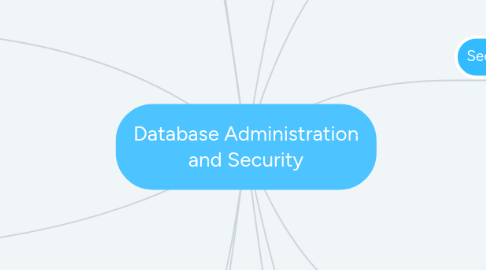
1. Evolution of Database Administration Function
1.1. Information system department
1.1.1. Provide end user with data management support and solution for information needs
1.2. Database adminstrator
1.2.1. Responsible for control of the centralized and shared database
1.3. System administrator
1.3.1. General coordinator of all BDAs
1.4. Data administrator/Information resources manager
1.4.1. High degree of responsibility and authority than the DBA
2. DBA's Managerial Role
2.1. Provide end user support
2.2. Enforce policies, procedures and standards for correct data creation, usage, and distribution within the database
2.3. Manage data security, privacy and integrity
2.4. Manage data backup and recovery
2.4.1. Fully recover data in case of data loss
2.4.2. Database security officer to ensure database security and integrity
2.4.3. Disaster management
2.4.4. Full backup/database dump
2.4.5. Incremental backup
2.4.6. Concurrent backup
2.5. Manage data distribution and use
3. DBA's Technical Role
3.1. Evaluate, select and install DBMS and related utilities
3.2. Design and implement databases and applications
3.3. Test and evaluate databases and applications
3.4. Operate DBMS, utilities and applications
3.5. Train and support users
3.6. Maintain the DBMS, utilities, and applications
4. DBA's Role in Cloud
4.1. DBMS installations and updates
4.2. Server/network management
4.3. Backup and recovery operations
5. Security Vulnerability
5.1. Weakness in a system component that could allow unauthorized access or cause service disruption
5.2. Categories
5.2.1. Technical
5.2.2. Managerial
5.3. Security threat
5.3.1. Imminent security violent
5.4. Security breach
5.4.1. Occurs when a security threat exploited and could lead to a database whose integrity is preserved or corrupted
6. CASE Tool
6.1. Automated framework of SDLC
6.2. Use structured methodologies and powerful graphical interfaces
6.3. Front-End CASE Tools
6.3.1. Provide support for the planning, analysis and design phases
6.4. Back-end CASE Tools
6.4.1. Provide support for the coding and implementation phases
6.5. Components
6.5.1. Graphics
6.5.2. Screen painters and report generators
6.5.3. Integrated repository
6.5.4. Analysis segment
6.5.5. Program documentation generators
7. Data
7.1. Dirty data
7.2. Data quality
7.3. Data profiling software
7.4. Master data management software
8. Special Consideration
8.1. Technological aspect
8.1.1. Select, install, configure and monitor DBS to ensure it operate efficiently
8.2. Managerial aspect
8.2.1. Careful planning to crete an appropriate organizational structure
8.3. Cultural aspect
8.3.1. Listen to people's concern about the system and explain its uses and benefits
9. Security Goals
9.1. Confidentiality
9.2. Compliance
9.3. Intergrity
9.4. Availability
10. Security Policy
10.1. Collection of standards, policies and procedures created to guarantee security
10.1.1. Ensure auditing and compliance
10.2. Security audit process
10.2.1. Identifies security vulnerabilities
10.2.2. Identifies measures to protect the system
11. Database Security
11.1. Features and related measures that comply with the security requirements
11.2. Authority management
11.2.1. User access management
11.2.2. View definition
11.2.3. DBMS access control
11.2.4. DBMS usage monitoring
12. Data Dictionary
12.1. Types
12.1.1. Integrated
12.1.2. Stand alone

